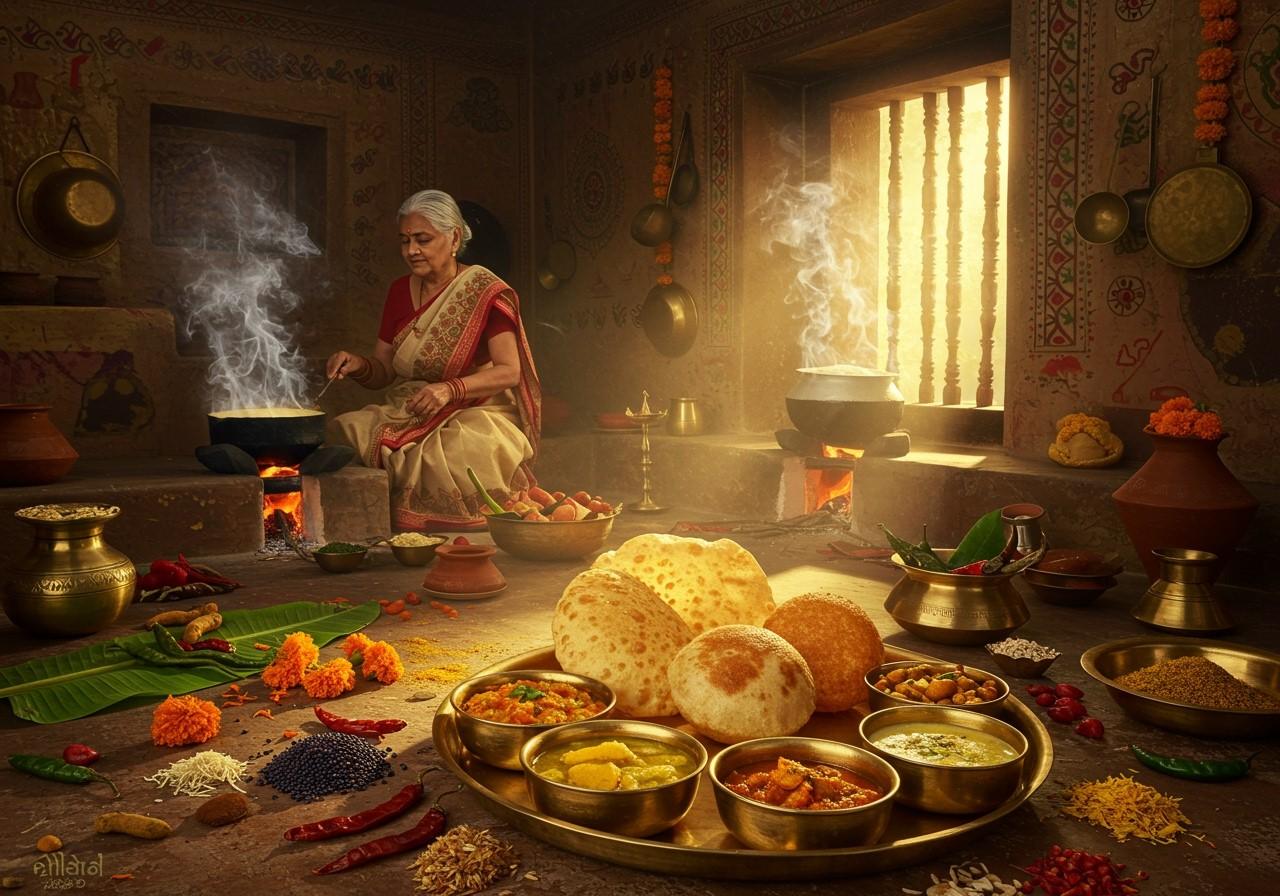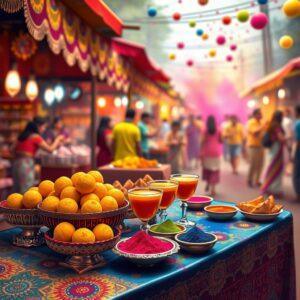
Explore the culinary heritage of the Anga region, nestled in parts of Bihar and Jharkhand. This area is rich in culture and offers unique traditional cuisine that has been cherished for generations. This exploration delves into the heart of Anga’s food culture, revealing its historical significance, signature dishes, unique ingredients, cooking techniques, festival traditions, and health benefits.
Historical and Cultural Significance of Anga Cuisine
Anga cuisine is deeply rooted in the region’s history and traditions. Over centuries, local festivals and rituals have shaped the food culture here. Agriculture plays a significant role, with rice, lentils, and seasonal vegetables forming the core of their diet. Community feasts are a testament to the socio-economic conditions, where traditional recipes are passed down through generations. Ayurvedic principles influence the cooking, ensuring health benefits are always considered. Food is not just sustenance but a vital part of the cultural identity in Anga.
Signature Dishes of the Anga Region
Discover some of the iconic dishes that define Anga cuisine:
- Anga Kozhi: A flavorful chicken dish enriched with local spices and herbs, offering a unique taste of the region.
- Pakhala Bhata: Fermented rice, a cooling and digestive dish perfect for hot summer days, representing a unique culinary tradition.
- Pittha: Steamed dumplings filled with sweet or savory ingredients, showcasing the versatility of Anga cuisine.
- Satu: Flour made from roasted gram, highly nutritious and used in various dishes, reflecting resourcefulness and health consciousness.
- Rasia: Sweet rice pudding with jaggery and milk, a delightful dessert representing the region’s sweet culinary traditions.
- Dal Pitha: Lentil-stuffed dumplings, both filling and healthy, showcasing the use of lentils as a staple ingredient.
These dishes use locally sourced and organic ingredients, adding to their authenticity.
Ingredients and Spices Unique to Anga Cuisine
Key components in Anga cooking include:
- Mustard oil: Adds a distinctive pungent flavor and is considered healthy in the region.
- Panch Phoran: A unique five-spice blend, creating a complex and aromatic flavor profile in dishes.
- Bamboo shoots: Common in various dishes, adding a unique texture and earthy flavor.
- Jaggery: A natural sweetener with health benefits, used in both sweet and savory dishes.
- Lentils: Varieties like moong, masoor, and chana are staples, providing protein and nutrients.
- Fresh herbs: Cilantro, mint, curry leaves are used to enhance flavors and add freshness to dishes.
- Locally grown vegetables: Bottle gourd, bitter gourd, drumsticks add regional flavors and nutritional value.
These ingredients are essential for preparing authentic Anga dishes. You can find high-quality green mung dal and other essential ingredients at poojn.in.
Cooking Techniques and Traditions
Traditional methods that define Anga cuisine:
- Slow cooking: Preserves natural flavors and nutrients, resulting in rich and flavorful dishes.
- Earthen pots: Add a rustic, earthy taste to the food, enhancing the traditional cooking experience.
- Fermentation: Aids digestion and adds unique flavors, used in dishes like Pakhala Bhata.
- Steaming: A healthy cooking method used for Pittha and Dal Pitha, preserving nutrients and flavors.
- Sun drying: Preserves ingredients like vegetables and fish, extending their shelf life and adding unique flavors.
- Community cooking: Strengthens social bonds during festivals, highlighting the social aspect of food in Anga culture.
- Open fire cooking: Enhances flavors during outdoor gatherings, adding a smoky dimension to dishes.
Festivals and Food Traditions
Anga cuisine is closely tied to its festivals:
- Chhath Puja: Thekua, a sweet wheat-based offering, is prepared with reverence and shared among devotees.
- Makar Sankranti: Sesame and jaggery sweets like Tilkut are made, celebrating the harvest season and symbolizing prosperity.
- Sama Chakeva: Celebrates sibling bonds with special foods, highlighting the importance of family ties and traditions.
- Holi: Traditional foods like Gujiya (sweet dumplings) and Malpua (pancakes) are enjoyed, marking the vibrant festival of colors.
- Diwali: A variety of sweets and snacks are prepared, symbolizing the triumph of light over darkness and shared with family and friends.
- Navratri: Fasting foods, often made with simple ingredients like potatoes and sago, are consumed, observing the nine nights of devotion.
These festivals keep traditional recipes alive and promote cultural heritage.
Health Benefits of Anga Cuisine
The nutritional aspects of Anga foods include:
- Fermented foods: Like Pakhala Bhata, improve gut health and aid digestion, promoting overall well-being.
- Lentil-based dishes: High in protein, essential for a balanced diet and muscle building.
- Mustard oil: Known for its heart-healthy properties and anti-inflammatory effects, contributing to cardiovascular health.
- Green leafy vegetables: Rich in vitamins and minerals, essential for maintaining overall health and preventing deficiencies.
- Fresh herbs: Enhance daily meals with their health benefits, providing antioxidants and boosting immunity.
- Spices: Turmeric and ginger boost immunity and have anti-inflammatory properties, contributing to overall well-being.
- Traditional sweets: Made with jaggery, a natural sweetener, are healthier than refined sugar, offering a guilt-free indulgence.
This culinary journey through the Anga region offers a glimpse into its rich gastronomic heritage, emphasizing both tradition and health.
Essential Pooja Items for Traditional Anga Cuisine
Poojn.in offers authentic ritual items essential for preparing traditional Anga region delicacies. The Ashan Anguri Madhuporker Bati, available at an affordable price, is a traditional utensil used in households for serving Madhuparka and other sacred offerings. This ritual vessel maintains the purity and sanctity of the food preparations. For added convenience during ceremonies, consider using a Plastic Comb (Kangi/Chiruni) for symbolic grooming rituals.
Conclusion: Celebrating Anga’s Culinary Heritage
Exploring the culinary delights of the Anga region is a journey through time and tradition. Each dish tells a story of the region’s rich history, cultural significance, and the love for authentic flavors. Anga cuisine is a testament to the community’s bond, the wisdom of Ayurvedic principles, and the joy of shared meals during festivals. By embracing these traditional foods, we honor the heritage and continue to pass down the delicious legacy to future generations. Whether it’s the comforting taste of Pakhala Bhata on a hot day or the festive sweetness of Thekua during Chhath Puja, Anga cuisine offers a unique blend of taste and health benefits.
FAQs on Culinary Delights from the Anga Region: A Traditional Food Guide
What is Anga cuisine?
Anga cuisine refers to the traditional food from the Anga region, known for its unique flavors and ingredients that reflect the area’s rich cultural heritage.
What are some popular Anga dishes?
Popular Anga dishes include Anga Kozhi (chicken), Pithha (rice cakes), and Bhunja (roasted grains). Each dish has its own unique preparation and taste.
How is Anga Kozhi prepared?
Anga Kozhi is made by marinating chicken with local spices and herbs, then cooking it over a low flame. This method enhances the flavors and makes the chicken tender.
Are Anga dishes spicy?
Anga dishes can be moderately spicy. The use of local spices like red chili, black pepper, and turmeric adds a distinct taste. However, the spice level can be adjusted to suit individual preferences.
Can I find vegetarian options in Anga cuisine?
Yes, Anga cuisine offers a variety of vegetarian dishes such as Pithha (rice cakes), Bhunja (roasted grains), and Saag (leafy green vegetable curry).
What ingredients are commonly used in Anga dishes?
Common ingredients in Anga dishes include rice, lentils, chicken, leafy greens, and a variety of spices such as turmeric, cumin, and coriander.
Is it possible to make Anga food at home?
Yes, you can make Anga food at home. Many traditional recipes are simple and use easily available ingredients. Following a traditional food guide can help you recreate the authentic flavors.
Why is Anga cuisine unique?
Anga cuisine is unique because of its use of locally sourced ingredients and traditional cooking methods that have been passed down through generations. This gives the dishes their distinctive taste and cultural significance.


